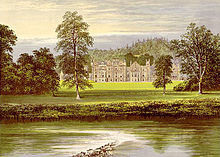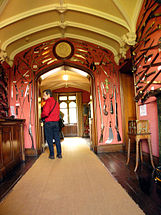Abbotsford
Abbotsford is a historic house 3 miles west of Melrose in the Scottish Borders Council Area in southern Scotland . It is on the south bank of the River Tweed . It was built for the Scottish writer Walter Scott , who named it Abbotsford, because land and Wade (English ford ) once the abbots (English abbots included) of Melrose.
Under Abbotsford style is today understood carved Victorian oak furniture that was made popular by the furniture of the library of Abbotsford.
Building history
The core of the property was a small farm (0.4 km²) called Cartleyhole, which was also jokingly called Clarty Hole (Mud Hole). Scott bought it from Reverend Robert Douglas of Galashiels in 1811 after his lease for the neighboring Ashestiel house expired. Through several acquisitions, most recently in 1817 by Toftfield (later renamed Huntlyburn), he expanded the area of the property to around 5 km² and planted trees on it. He redesigned the buildings of the original farm through renovations and substantial extensions until 1824 gradually to the Abbotsford House, where he built many sculptures from Scottish castle ruins and abbeys in the walls. For the construction of this house he consulted Edward Blore and Daniel Terry, among others , but oversaw the planning and construction work on the building personally, choosing William Atkinson as the architect . He set up a large library and collected antiques , paintings, weapons and other relics and curiosities particularly connected to Scottish history, for example the entrance to old Tolbooth in Edinburgh .
Abbotsford House's floor plan is a parallelogram with irregular contours. One side overlooks the tweed. The house is built in the style of the early Scottish Baronials . Washington Irving in Abbotsford and Newstead Abbey (London 1835) gave a description of the building during Walter Scott's lifetime .
Ownership history
After the building was completed in 1824, Scott had lived in his residence for just a year when he got into a serious financial crisis . Although he had already transferred ownership of the property to his son Walter, his reserved right of residence, the valuable library and collection, and Scott's other property came under trust management. Because of Scott's vigorous debt settlement activities, creditors released the library and museum in 1830. In 1832 the poet died in Abbotsford. In 1847 the property was completely discharged through the sale of the remaining copyrights to Scott's works to the bookseller Robert Cadell .
Scott's only son Walter never lived in the house. He served in the military and died childless on the journey home from India in 1847. With his death, the Abbotsford-based baronet title of the family expired. The property then fell to Scott's grandson Walter Scott Lockhart (1826-1853) and, after his untimely death, to his younger sister Charlotte Harriet Jane Hope-Scott, b. Lockhart (1828-1858). She was married to James Hope-Scott (1812-1873), who in 1855 had a south wing attached to Abbotsford House. Charlotte Harriet Jane Hope-Scott, who converted to Catholicism, died on October 26, 1858, leaving behind an only daughter, Mary Monica Maxwell-Scott (1852-1920), while Abbotsford was left to a Catholic association to establish a fräuleinstift. After the death of her father in 1873, she inherited the property. This was still inhabited by Scott's descendants into the 21st century. In order to ensure the preservation of the house and the collections in it in the long term and for the public, it was transferred from the heirs to the Abbotsford Trust , which was founded for this purpose, after the death of Jean Maxwell-Scott (2004) .
The Abbotsford Club, a successor to the Bannatyne and Maitland Clubs, was named after the house. This was founded by WBDD Turnbull in 1834 in honor of Walter Scott to print and publish historical works associated with his writings. The publications were there from 1835 to 1864.
Quote
Theodor Fontane , an admirer of Sir Walter Scott, visited Scotland in 1858. He mentions Abbotsford several times in his essays.
"[...] The whole building takes against his will, the argument that, a non-for all done" and that the revival of the past, which decorate a modern creation with the rich poetic Details of the Middle Ages in an area enchanted and carried away, and on the others can become a mere purr and peculiarity. This romance in stone and mortar, in order to remain in the comparison that the poet (Scott) himself wanted, only looks as if he had collected a hundred pretty passages from all kinds of ballads in one of his desk boxes, in the certain expectation to be able to achieve an actual pattern romance by putting together such fragments . What is missing is the flash of inspiration strong enough to fuse the conflicting elements into something unified. How society makes poems by rhymes and the paper flips to completely out of the context of the stay, who wrote his line before us, Abbotsford was built one-half hundred keywords sake. None of this should be a reproach to its builder; but one regrets, however, that the stone romance is not able to strike the tone of love and admiration to which the lips have almost become accustomed when they mention the name Sir Walters. "
- The Scotts Collection
literature
- Frank Druffner: Walter Scott's romance in stone: Abbotsfort as a picturesque poet's residence. Manuscripts for art history in the Wernerschen Verlagsgesellschaft 4., Worms 1987. ISBN 978-3-88462-505-7
Web links
- Washington Irving : Abbotsford and Newstead Abbey. Chapter 1: Abbotsford. 1835. (English, report by the American writer on a visit to Abbotsford)
- Abbotsford , in Encyclopædia Britannica online
Individual evidence
- ^ Theodor Fontane: Abbotsford. In: Wanderings through England and Scotland. Second volume, 2nd edition. Verlag der Nation, Berlin 1991, ISBN 3-373-00475-6 , p. 296.
Coordinates: 55 ° 35 ′ 58 " N , 2 ° 46 ′ 55" W.






